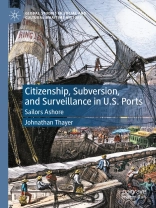This book argues first, that the forces of industrialization that transformed ship technology simultaneously transformed the working-class lives of merchant seamen, intensifying class conflict and producing collective networks of subversion and resistance within the urban borderland spaces of sailortowns in which sailors fought to maintain control over their mobility, agency, and rights. Second, that given their social, cultural, economic, geographic, and legal marginalization, merchant seamen have occupied essential roles at the parameters of US urban, legal, labor, immigration, and wartime history. Third, that the constellation of these histories, embedded in the encounters and negotiations that merchant seamen provoked along the nation’s coastlines and sailortowns, collectively represents a unique and essential perspective on the history of US citizenship.
İçerik tablosu
Introduction: Sailors Ashore.- Chapter 1. Sailors’ Wardship, Maritime Ministry, and the Contest for New York City’s Sailortown, 1843-1915.- Chapter 2. Merchant Seamen and the Parameters of Involuntary Servitude: The Arago Deserters and the United States Supreme Court, 1895-1897.- Chapter 3. “Pandemonium on the Quay”: The Titanic Disaster, the Olympic Mutiny, and the 1912 Transport Workers’ Federation Strike.- Chapter 4. The 1915 Seamen’s Act: Maritime Labor and Progressive Era Maritime Reform.- Chapter 5. Deserters, Stowaways, and Mala Fide Sailors: Merchant Seamen and the Shaping of U.S. Immigration Policy, 1917-1936.- Chapter 6. The “Million-Dollar Home for Sailors, ” Industrial Maritime Unionism, and Sailors’ Agency in New York City’s Sailortown, 1930-1932.- Chapter 7. Conclusion: Currents, Past and Future.
Yazar hakkında
Johnathan Thayer is Assistant Professor at the Graduate School of Library and Information Studies, Queens College, City University of New York (CUNY).












